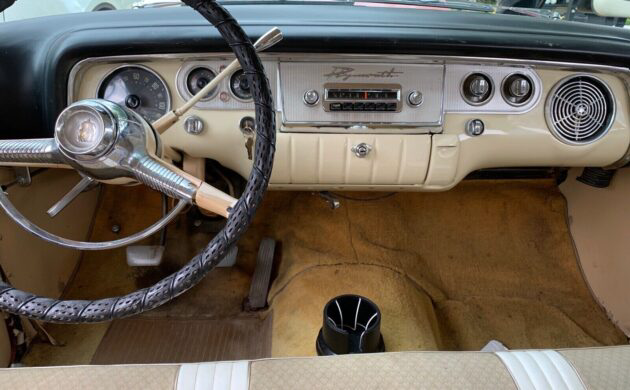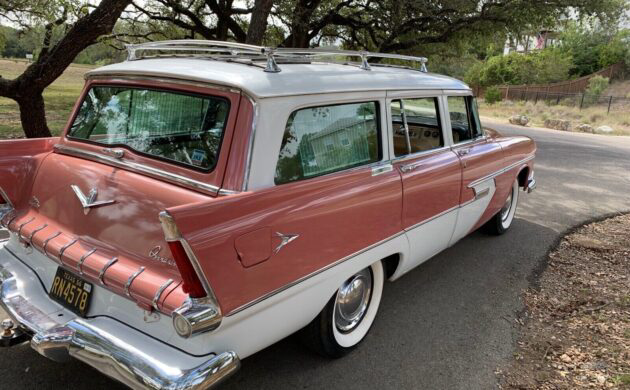When I think of a Suburban, I think of my friend’s 1990s green Chevrolet, too large for most parking spots but capable of carrying her entire landscape design business and a dog besides. What I didn’t appreciate until now is “Suburbans” have been made by a wide variety of carmakers from DeSoto to Studebaker, and that its generic meaning is “wagon on a truck frame.” GM didn’t trademark the word for use in its lineup until May 31, 1988, but before then, it was the Wild West as far as Suburbans went. Who knew! Here on eBay is a 1956 Briar Rose over Eggshell White Plymouth Suburban, bid to $11,201, reserve not met. Located in Spicewood, Texas, this wagon can be driven to its new home though the buyer might want to pack a few tools just in case.
Plymouth began making the Suburban in 1949, introducing it as the first all-steel wagon (defined by a tailgate – the DeSoto version is all steel and was made a few years earlier, but has no tailgate). The all-steel body dramatically reduced manufacturing costs. By 1956, Plymouth was producing its wagon in De Luxe, Custom, and Sport trim, with two or four doors. The Sport Suburban corresponded to the top-shelf Belvedere. Several motors were available; this one is the 277 CID V8 with a two-barrel carburetor making about 187 hp and paired with a three-speed manual overdrive gearbox. During the seller’s six-year ownership, he has renewed the suspension, clutch, brakes, starter, water pump, and carburetor. Consumables including the fluids, belts, and hoses have also been replaced.
The interior is very presentable except for the aftermarket carpet, which has a few odd seams and doesn’t fit correctly. The seller pulled the dash and repainted it; the gauges have also been rebuilt. I don’t care for wraps on steering wheels, which often hide damage, but in period, these were de rigueur. The snazzy factory radio was rebuilt with a bluetooth connection; the speakers are new. The unusual ribbed plastic headliner is still present.
If you think you see Virgil Exner in these design lines, you are absolutely right. The “Forward Look” was just a year old and entering full swing, as fins grew and trim lines multiplied. This car has received a repaint at some point in its history; there are a few bumps to the bumpers, small rust spots above one wheel arch, one cracked tail lamp – but for its age, this car looks great. The badge on the left shows the dealer’s name (Giles Motor Center), and on the right, it reminds us of the car’s overdrive option. The cargo area is tidy. The seller will include documentation including manuals, work and parts receipts, and registrations back to 1960. This well-kept Plymouth deserves at least its current bid; here’s a plain Jane Custom Suburban project car that sold for $8500 despite requiring considerable work.






Now I like this one. Bidding is up to $13k but still a fair deal if it looks as good on the bottom as it does on top. Can’t ask for better than a V8 and manual transmission. I’d put vintage air and use it to haul my old wooden boat to the lake in style.
It already has a hitch. lol. It’d look good with a canned ham behind it too…or a vintage racer.
V8 too! I am glad it is not the six, such dogs.
Not so fast my friend. As a youngster I remember riding in my grandmothers’ 1956 Plymouth with a six-cylinder and at a stop the engine was so quiet I couldn’t hear it. And, I never remember her having it leave her stranded. That was in the late 50’s into the 60’s.
First year for the 12 volt system too. I wish my 55 Belvedere 6 had had that.
I’ve never seen a 56 Plymouth that I didn’t love, and this wagon is no exception. I would like it better if it had an automatic with push button shift but that might not be everyone’s opinion. I had a 56 convertible and sold it when I went into Air Force basic training in 1959. Bought a 58 when I got back home. I have always wanted a 56 Fury but never found one for sale when I had both the money and a place to keep it at the same time. Nice car, I hope the next owner keeps it nice.
I love it! It’s a year older than me, and looks way better.
Hopefully it will go to a good home, and be preserved.
“The Forward Look” is timeless.
Upgrades and maintenance always cost significantly less when done by the previous than if you buy a car with needs and have pay for it yourself.
The rear end reminds me of a Packard wagon.
Look at that backend… reminiscent of Studebaker/Pakard and American Motors ? Exner get around?
Willys was the first all steel wagon before Plymouth.
The economy ’55 of this with the 6-cylinder & 3-speed G/B is what took the Wirts to Holyoke Mass & back in ’58, towing a trailer painted to match & camping along the way. Dad was a New England Plymouth guy with a heart of gold & nerves & endurance of steel. A tough act to follow!
Charles, a 55 Plymouth with that flat head six with 3-speed was not the underpowered slug that those who have never experienced one might think. My Dad, ever the one to save money, bought a new 55 Savoy 4-door with absolutely NO options. No radio, and no heater, and of course no whitewall tires or full wheel covers. He bought a radio and heater from Western Auto. I didn’t have my license at the time so I only drove it when accompanied by a parent, but my 17 YO brother drove it often and usually, fast. It was surprisingly fast for what it was, and surprised other drivers occasionally. BTW, there was three Plymouths with that little six in our family at that time, a 51 convertible, and our 50 Suburban.
In 1957, when I was 7 years old, our 1951 Studebaker Starlite coupe was T-boned and my dad tried to fix it, but the frame was bent. One day soon after, he came home with a repossessed ’56 Plymouth Savoy four door sedan, with the 277 and pushbutton two speed auto. No PS, PB, or air. We travelled all over in that car, even from Pueblo CO to Seattle for the 1962 World’s Fair. I don’t remember having much trouble with the car over 135,000 miles. My brother owned the car last, in 1969 when he traded it for a 1959 Thunderbird.
I do remember that if you got on the gas when the car was cold, it would blow the rear transmission seal. That V8 always had plenty of power, even with the two speed slushbox. I wouldn’t drive it to school because it was a four door, with an automatic. My car was a 1951 Ford I had built myself, but it wasn’t as reliable as te Plymouth.
What a nice old wagon, i woud love to own it